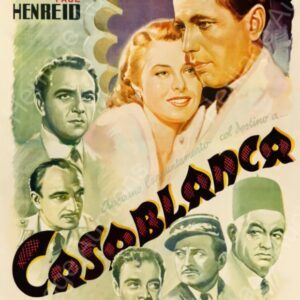It’s still the same old story.
Eighty years ago this month, Americans first plunked down a quarter for a ticket at their local movie house and fell in love with a love story. The affair is still going strong four generations later.
What is it about “Casablanca” that won’t let go of our collective soul? Is it the “it’s complicated” aspect of Ilsa’s torn-between-two-lovers angst? Is it Rick’s alarmingly moral ambivalence? Is it lingering revulsion at the Nazi threat when a millennium of Western civilization was hanging in the balance?
It’s all of the above. And yet something else also keeps us watching the cheap toy plane coming in for a landing in the film’s opening scene as refugees gaze hopefully at the promise of freedom carried on its wings. We surge with admiration for Victor’s unsullied idealism and envy him for having a pure cause for which to fight. And yes, we even laugh at Louis’ reveling in the corruption he doesn’t bother to hide.
All that was unimaginable to the big brass at Warner Brothers back in 1942. To them, the movie was just another widget on the Dream Factory’s assembly line. After all, the studio system back then was famous for its “we don’t want it good, we want it Wednesday” approach to filmmaking.
Pearl Harbor had been attacked just months earlier, and Warner was eager to cash in on the massive public outpouring of support for the war effort. Two years earlier, it had shelled out $20,000 — about $365,000 today — for the rights to a play that had never been produced called “Everybody Comes to Rick’s.” (Why it never made it to Broadway is a story itself.)
Writers jumped into the script, overhauling and updating it with wild abandon. The setting was shifted from Lisbon, Portugal, to Casablanca in French Morocco. In fact, filming started before the writing was even finished. (More on that in a moment.)
The movie features some of Hollywood’s most inspired casting, though it worked for reasons the producers didn’t realize at the time. Humphrey Bogart, for example, didn’t want to be in it and had to be dragged to the project, kicking and screaming. His sullenness was a perfect fit for Rick Blaine’s bourbon-blurred bitterness.
“Casablanca” was one of 27-year-old Ingrid Bergman’s early American films. Though she had become a box-office favorite in previous hits like “Intermezzo,” she wasn’t convinced her Swedish accent would work in this particular vehicle. Her hesitancy seeps through as her heart sways back and forth between the two men she loves.
Claude Rains was the only major star who wanted to be in the movie. His unfettered joy nearly steals the show as he romps through it as Louis Renault, the Free French prefect of police, unbothered by a conscience.
Shooting began on May 25 and wrapped up on August 3. The production schedule was moving faster than the writers, who hadn’t decided how the story would end. They discussed several possibilities: Ilsa leaves with Victor; Ilsa stays in Casablanca with Rick; even a third conclusion where the movie ends without viewers knowing what she did.
They started by filming the finale where she got onboard the plane, and that was it. Everyone knew they had the right ending.
Yet “Casablanca’s” remarkable story wasn’t finished. Fate decided to step in a lend a helping hand.
In early November 1942, American troops landed in French Morocco in Operation Torch. It was the first time U.S. troops took on the Nazis in direct battle. Interest in the fighting reached a fever pitch at home. And, Warner’s executives noted, it was happening near the scene of their coming feature film. It was a promotional bonanza the studio hadn’t seen coming.
Post-production went into overdrive, and “Casablanca” premiered to great fanfare in New York on Nov. 26.
But Fate wasn’t finished with the film. As luck would have it, Casablanca was selected as the site of a high-profile meeting between President Franklin Roosevelt and British Prime Minister Winston Churchill. The film went into wide release on Jan. 23, 1943, piggybacking off news coverage of the Allied leaders’ conference. The movie went on to win Best Picture and Best Director at the 1943 Academy Awards. And though it wasn’t a box-office smash, it made a respectable profit.
In the end, television turned “Casablanca” into a beloved classic. It became a staple of afternoon matinees and late-night reruns on hundreds of local stations from the 1950s into the 1980s. The original moviegoers, then their children and eventually their grandchildren all fell in love with the timeless tale of star-crossed lovers swept up in the battle between good and evil.
Many experts consider it a masterpiece. And interest in it shows no signs of fading. Maybe we won’t always have Paris, but we’ll always have this cinematic treasure.
So, here’s looking at you, kid. Happy 80th birthday, “Casablanca.”
Please follow DVJournal on social media: Twitter@DVJournal or Facebook.com/DelawareValleyJournal

